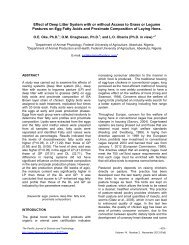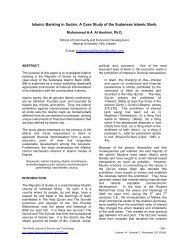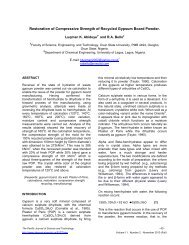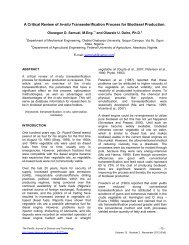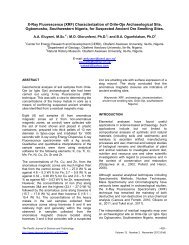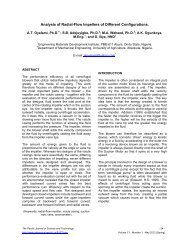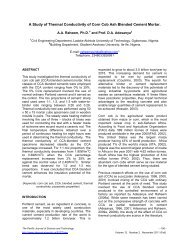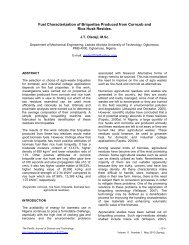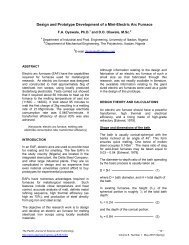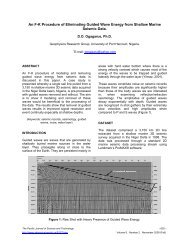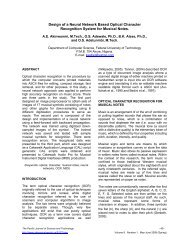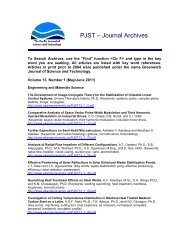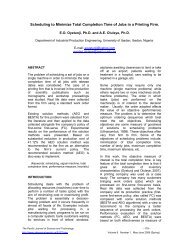Design and Fabrication of Motorized Hydraulically Operated Palm ...
Design and Fabrication of Motorized Hydraulically Operated Palm ...
Design and Fabrication of Motorized Hydraulically Operated Palm ...
You also want an ePaper? Increase the reach of your titles
YUMPU automatically turns print PDFs into web optimized ePapers that Google loves.
Pressure on the Cage:<br />
The force exerted on the cage walls is given:<br />
Force = Ram pressure x Area <strong>of</strong> pressing plate<br />
The ram pressure = 206.85KN/m 2<br />
Force, F = Pressure x Area<br />
= 206.85 x 0.12 = 24.82KN<br />
= 24.82KN.<br />
The test was carried out for three different times<br />
<strong>and</strong> average time recorded. The average time <strong>of</strong><br />
pressing was found to be 4.35 mins. The result <strong>of</strong><br />
the three presses are tabulated below (Table 2).<br />
Table 2: Result <strong>of</strong> the Three Tests Carried Out<br />
Using the Machine.<br />
Different tests Time <strong>of</strong> press (Sec.)<br />
First test 265<br />
Second test 271<br />
Third test 247<br />
RESULTS AND DISCUSSION<br />
After the palm fruits were digested <strong>and</strong> separated,<br />
the pressing plate was removed <strong>and</strong> the cage was<br />
locked with the “Tee” lock on the circumference <strong>of</strong><br />
the cage. The hydraulic oil tank was filled to attain<br />
the required level to avoid the suction <strong>of</strong> air. The<br />
connections were checked to avoid leakage. This<br />
was to avoid loss <strong>of</strong> pressure that will affect the<br />
pressing pressure <strong>of</strong> the ram piston. The digested<br />
pulp is fed into the cage. The pressing plate was<br />
replaced. The 5hp electric motor transmits power<br />
<strong>and</strong> rotary movement to the pump pulley, this<br />
cause the hydraulic oil from the tank to be sucked<br />
via the hose into the pump, the oil passed through<br />
the pressure hose into the ram through the valve<br />
inlet channel to the upper chamber <strong>of</strong> the ram<br />
thereby building up pressure for pushing down the<br />
ram. The ram moved down when the lever on the<br />
valve was gently pressed downwards. This<br />
requires little or no effort.<br />
After the press is completed the lever is pushed<br />
up again to return to its position. This caused the<br />
hydraulic oil to enter the ram through the lower<br />
nozzle thereby pushing the ram up. This upward<br />
movement expels the fluid in the upper chamber<br />
<strong>of</strong> the ram back to the tank. The motorized<br />
hydraulically operated palm oil press (Figure 3)<br />
was less time consuming <strong>and</strong> less energy<br />
dem<strong>and</strong>ing as compared to some <strong>of</strong> the expeller<br />
that is known (manual screw pressure where two<br />
or more people will exhaust all their energy in one<br />
pressing). Time used in pressing large quantity <strong>of</strong><br />
digested fruit is reduced compared to other types<br />
<strong>of</strong> palm oil presses encountered. The issue <strong>of</strong> the<br />
strength <strong>and</strong> capability <strong>of</strong> the operator required in<br />
screw press is sorted out using this palm oil press.<br />
The hydraulic pressure extracts oil from the<br />
digested fruit with less labor or drudgery. The<br />
pressing time was also recorded.<br />
Figure 3: <strong>Design</strong>ed <strong>and</strong> Fabricated <strong>Motorized</strong><br />
<strong>Hydraulically</strong> <strong>Operated</strong> <strong>Palm</strong> Oil Press with the<br />
<strong>Design</strong>er Beside it.<br />
CONCLUSION<br />
The design <strong>and</strong> development <strong>of</strong> motorized<br />
hydraulic operated palm oil press has been<br />
reported. The demonstration showed that the<br />
equipment performed well in palm oil pressing.<br />
The capacity <strong>of</strong> the machine is 330.96 KN/m 2 .<br />
The time required to completely press the pulp<br />
that fill the cage is 4.5mins. The press has been<br />
designed generally to meet the need <strong>of</strong> both local<br />
<strong>and</strong> commercial farmers. Appropriate design<br />
consideration <strong>and</strong> technicalities have been taken<br />
into account to ensure the durability <strong>of</strong> the<br />
machine.<br />
The Pacific Journal <strong>of</strong> Science <strong>and</strong> Technology –87–<br />
http://www.akamaiuniversity.us/PJST.htm<br />
Volume 14. Number 1. May 2013 (Spring)



